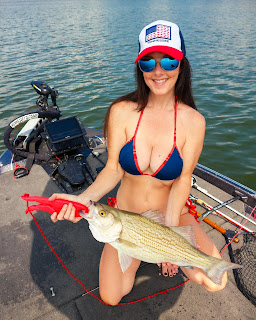A serious situation for rockfish in the Chesapeake Bay.
It seems the environment is causing big problems for the Chesapeake Bay. The Department of Natural Resources just released their survey for juvenile striped bass otherwise known as rockfish, otherwise known as rockfish. The population numbers are well below average.
DNR reported, "The 2023 young-of-year index is 1.0, well below the long-term average of 11.1."
According to DNR, unusually warm winters and spring seasons over the past few years have hurt reproduction for the rockfish. DNR is partnering with The Atlantic Marine Fisheries Commission and they are already in the process of looking at more regulations. They say they can't control the weather, but they can manage regulations.
Mike Luisi the assistant director with DNR's fishing and boating services says, "We've had a number of poor year classes now in row. Unless something changes environmentally and the conditions are changed for this coming winter it's just going to continue."
And regarding possible new regulations, Luisi says, "Right now in Maryland we have a 31 inch maximum size limit in place, recreationally. All of the options in the current addendum are smaller than that." Luisi went on to say that if regulations were to change, the maximum size limit would be 23 to 26 inches.
DNR is also looking at reducing fish mortality. Luisi explained that more regulations could be placed regarding 'catch and release' for recreational anglers. He says they're trying to reduce the number of large fish that die from being caught.
But commercial rockfish fisherman John Motovidlak says there is no need to panic.
Motovidlak says fishing has been great. "Well, this morning we left at 6:30. At 9:00, we had caught our limit of 12 fish and probably threw 20 undersized fish back. We saw plenty of small fish."
Motovidlak says regulations are not the way to go. He says, "What else can they take away from us but days? Which is really gonna hurt us financially. Like I said, there is not a whole lot they can do. I think they're panicking." He explained that more energy and money should be put towards the natural causes of a the low population like dealing with the blue catfish population.
Typical of Maryland watermen to think that the solution to the rockfish issue is to eliminate a predator (or the competetion). A few years ago, they were touting catching more rockfish as the solution to a perceived problem with Blue Crab population. There's nothing stopping watermen from catching and selling every last Blue Cat in the Bay, except for a poor market and low prices.
These regulations are only a possibility at this point. A public discussion with DNR and the Atlantic States Marine Fisheries Commission will be held Oct. 18. No decisions will be made until January 2024.
By my personal observations, rockfish populations are way down. We used to often see large schools of them out in the main Bay in front of our beach. Now it's extremely rare. Commercial fisherman continue to catch their quota's because they cooperate to some extent to locate the increasing rare schools of fish. Until the Bay has a great year class (or two) and those fish have 3-4 years to grow to harvestable size, the rockfish population, and breeding stock will continue to diminish. I suspect another moratorium is coming, if not this year, then the next.
 |
| Pompano Dolphin? |
Humphrey, 38, of Ellicott City, didn’t know what was on the line, but he knew it was something different from what he had been looking for and reeled it in. Soon, he recognized the fish as a great barracuda and called the Maryland Department of Natural Resources to measure it in hope of entering a state record.
Humphrey’s Oct. 6 catch of a 13-pound barracuda established a species record in the Atlantic division of the Maryland state fishing records program. Chris Stafford of Cherry Hill, N.J., also established a species record with his Sept. 20 catch of a two-pound pompano dolphinfish.
.jpg) |
| Great Barracuda |
“It’s fun seeing what you see out there,” said Humphrey, who is a general contractor. “I think a lot of people take for granted how closely we are intertwined with nature and how close we live to some pretty magnificent creatures.”
Maryland officials say there have been stray barracudas spotted before and suspect pompano dolphinfish have been caught and overlooked because of their similarities to a regular dolphinfish.
These species are among the fish more commonly found in southern waters, but warming ocean temperatures have led to more sightings of southern fish in northern waters, including spotted sea trout, cutlassfish, cobia, red drum and sheepshead, said Erik Zlokovitz, a recreational fisheries outreach coordinator with the state’s natural resources department.
“We think that conditions will be conducive to seeing more of these fish in the future with climate change along the East Coast,” Zlokovitz said. “They could be showing up in greater numbers.”
Over the past few years, the Red Drum (aka Redfish) numbers in the Bay have sharply increased. I suspect it's mostly due to the recovery of the species from the "Blackened Redfish" craze that really hit the species. Florida and Texas have had very good success with their Redfish recovery programs. The last couple of years have seen Cobia in moderate numbers, at least enough that people actually go out to target them specifically. Spotted Sea Trout (aka Specks) have always been around, and their good years and bad years are clearly linked to weather. Bad freezes kill Specks. I'm looking forward to Tarpon becoming common (a few are caught in the Virginia portion of the Bay, by a few people who know how).
The Wombat has Rule 5 Sunday: Best Wrench Wench And Gun Bunny Too? up at The Other McCain more or less on time.


No comments:
Post a Comment